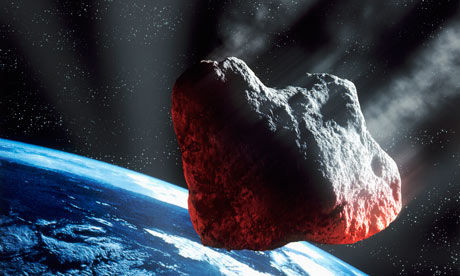
A lump of space rock the size of a small house will hurtle past Earth on Monday evening in a close encounter that poses no threat to the planet, astronomers said today.
The asteroid, which is 8 metres across and called 2011 MD, is due to pass within 12,000km of Earth, making its closest approach over the southern Atlantic Ocean at around 6.14pm BST on Monday evening.
With clear skies, the asteroid may reflect enough of the sun's light as it shoots past to be visible to amateur astronomers with sizeable telescopes.
The rock - a fragment smashed off a much larger asteroid - was spotted by astronomers last week using a pair of robotic telescopes in Socorro, New Mexico.
Images from the telescopes taken at different times are overlaid to reveal moving objects against the starry background. Scientists estimated the asteroid's size by measuring its brightness and making assumptions about its chemical composition.
Kevin Yates, manager of the Near Earth Object Information Centre in Leicester, said: "This a tiny asteroid by any standards. It's at the limit of what can be detected."
The asteroid is circling the sun at a speed of 29 kilometres per second on a similar path to Earth's and makes a complete orbit every 396.4 days. Nasa officials said an object of comparable size could be expected to come this close to Earth once every six years.
The asteroid will pass between the Earth and the moon's orbit, making it an official "intruder" in astronomy terms. As it passes by, the rock will enter a region of space around our planet known as its Hill sphere, where Earth's pull is the dominant gravitational force on other objects.
"As the asteroid passes by, its orbit will be changed and no one knows what that means for future passes and whether it will eventually collide with the Earth.
"If it does collide, the majority of it will burn up in the atmosphere and we'll get a few meteorites on the ground. If those are found, they will tell us something about its origins," Yates told the Guardian.
On Monday the asteroid will cross the orbits of geostationary satellites, but the odds of the rock striking a satellite are extremely low, Yates added.
Astronomers rank the danger posed by approaching asteroids on the Torino scale, which ranges from zero - when there is no chance of a collision, or the object is bound to burn up in the atmosphere - to 10, when a collision is certain and could cause a global climatic catastrophe that may "threaten the future of civilisation as we know it". Nasa officials have ranked asteroid 2011 MD as a zero on the scale.
The space rock will have started life billions of years ago in the asteroid belt that lies between Mars and Jupiter. The asteroid could be rich in carbon or may be a solid lump of iron and nickel.
Although the event will be a close shave in astronomical terms, the record for a passing asteroid is held by 2011 CQ1, which came within 5,480km of Earth in February.



The question is.... what are they NOT telling us?
Probably a lot. And that's a worry.